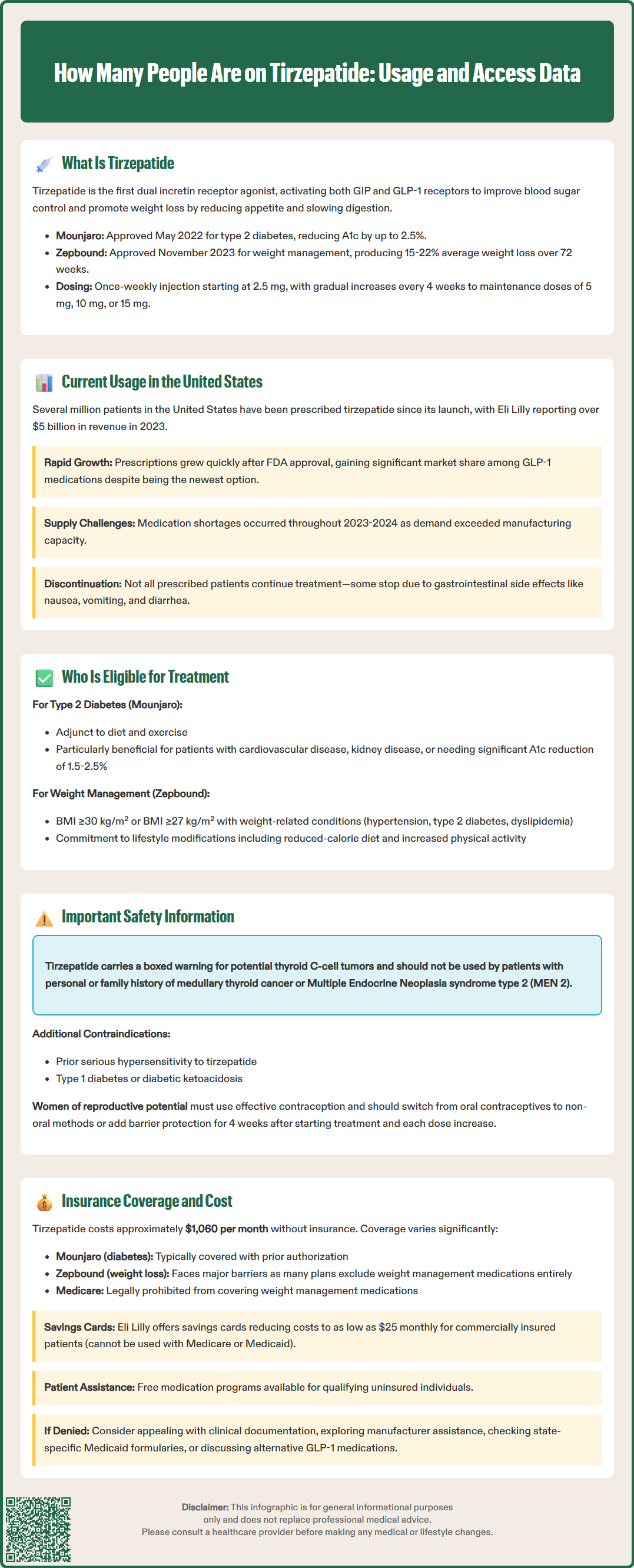LOSE WEIGHT WITH MEDICAL SUPPORT — BUILT FOR MEN
- Your personalised programme is built around medical care, not willpower.
- No generic diets. No guesswork.
- Just science-backed results and expert support.
Find out if you’re eligible

Tirzepatide, marketed as Mounjaro for type 2 diabetes and Zepbound for weight management, has rapidly become one of the most prescribed medications in its class since FDA approval in 2022. While precise real-time data remains limited, prescription tracking services indicate several million Americans have been prescribed tirzepatide across both indications. Understanding how many people are on tirzepatide requires examining prescription trends, patient eligibility criteria, and access barriers including insurance coverage and supply constraints that significantly impact who can obtain this dual GIP/GLP-1 receptor agonist medication.
Quick Answer: Several million Americans have been prescribed tirzepatide (Mounjaro/Zepbound) since its 2022 FDA approval, though exact current user numbers are unavailable due to discontinuations and access barriers.
Tirzepatide is a novel glucose-dependent insulinotropic polypeptide (GIP) and glucagon-like peptide-1 (GLP-1) receptor agonist approved by the FDA for two distinct indications. Marketed as Mounjaro for type 2 diabetes mellitus and Zepbound for chronic weight management, tirzepatide represents the first dual incretin receptor agonist available in clinical practice.
The medication works through a unique dual mechanism of action. By activating both GIP and GLP-1 receptors, tirzepatide enhances glucose-dependent insulin secretion, suppresses inappropriately elevated glucagon secretion, and slows gastric emptying (though this effect may diminish over time). These combined effects result in improved glycemic control in patients with type 2 diabetes. Additionally, tirzepatide acts on central appetite regulation pathways, leading to reduced caloric intake and significant weight loss.
Mounjaro received FDA approval in May 2022 as an adjunct to diet and exercise to improve glycemic control in adults with type 2 diabetes mellitus. In the SURPASS clinical trial program, tirzepatide demonstrated hemoglobin A1c reductions of up to 2.5% from baseline and superior glycemic control compared to semaglutide 1 mg in the SURPASS-2 trial. The medication is administered as a once-weekly subcutaneous injection, with a recommended starting dose of 2.5 mg, increased by 2.5 mg every 4 weeks until the maintenance dose (5 mg, 10 mg, or 15 mg) is reached.
Zepbound was approved in November 2023 for chronic weight management in adults with obesity (BMI ≥30 kg/m²) or overweight (BMI ≥27 kg/m²) with at least one weight-related comorbid condition. In the SURMOUNT-1 trial, patients achieved average weight loss of 15% (10 mg dose) to 22% (15 mg dose) over 72 weeks.
Importantly, tirzepatide carries a boxed warning for thyroid C-cell tumors observed in rodent studies. It should not be used in patients with a personal or family history of medullary thyroid carcinoma or Multiple Endocrine Neoplasia syndrome type 2.
Determining the precise number of individuals currently using tirzepatide presents methodological challenges, as comprehensive real-time prescription data across all healthcare settings is not publicly available. However, available evidence from pharmaceutical sales data, insurance claims analyses, and manufacturer reports provides reasonable estimates of the medication's reach.
Based on prescription tracking services such as IQVIA and Symphony Health, which monitor dispensing patterns across retail, mail-order, and specialty pharmacies, several million patients in the United States have been prescribed tirzepatide across both its branded formulations (Mounjaro and Zepbound) since launch. Eli Lilly, the manufacturer, reported that Mounjaro generated over $5 billion in revenue in 2023, indicating substantial patient utilization.
It is important to note that prescription numbers do not directly equate to active users at any given time. Some patients discontinue treatment due to adverse effects—most commonly gastrointestinal symptoms including nausea, vomiting, and diarrhea—while others face access barriers related to insurance coverage or medication shortages. The FDA has listed various tirzepatide dose strengths on its drug shortage database throughout 2023-2024 due to demand exceeding manufacturing capacity.
The patient population spans both approved indications, though precise distribution between diabetes and weight management use remains unclear. Healthcare utilization patterns indicate that tirzepatide users are predominantly managed in primary care and endocrinology settings, with growing adoption in obesity medicine and bariatric programs.

Tirzepatide has experienced significant growth in prescription volume since its initial FDA approval in May 2022. This trajectory reflects both the medication's clinical efficacy and the substantial unmet need in diabetes and obesity management.
Following Mounjaro's approval, prescriptions increased rapidly according to prescription tracking data from IQVIA and Symphony Health. By the end of 2022, tirzepatide had gained substantial market share within the broader GLP-1 receptor agonist class, despite being the newest entrant in this therapeutic category.
The approval of Zepbound in November 2023 further accelerated growth, particularly as it provided a pathway for insurance coverage specifically for weight management. This growth occurred despite ongoing supply constraints that limited availability at various dose strengths throughout 2023 and early 2024, as documented on the FDA's drug shortage database.
Several factors have driven this adoption. Clinical trial data from the SURPASS program demonstrated efficacy compared to existing treatments. In SURPASS-2, tirzepatide showed greater A1c reductions and weight loss than semaglutide 1 mg. The SURMOUNT-1 trial demonstrated substantial weight loss benefits in patients with obesity. Additionally, increased patient awareness and healthcare provider familiarity with the medication class have contributed to prescription growth.
Analysts continue to monitor prescription trends as manufacturing capacity expands and insurance coverage evolves. The long-term utilization patterns will depend on multiple factors including clinical outcomes, safety profile, access, and the emergence of additional treatment options in this therapeutic space.
Eligibility for tirzepatide treatment depends on the specific indication, with distinct criteria for diabetes management versus weight loss. Healthcare providers must carefully assess patient characteristics, comorbidities, and potential safety concerns before initiating therapy.
For type 2 diabetes (Mounjaro), the FDA-approved indication includes adults with type 2 diabetes mellitus as an adjunct to diet and exercise to improve glycemic control. The American Diabetes Association (ADA) 2024 Standards of Care support GLP-1 receptor agonists or dual GIP/GLP-1 receptor agonists, including tirzepatide, particularly in patients with:
Established atherosclerotic cardiovascular disease or high cardiovascular risk
Chronic kidney disease
Need for substantial A1c reduction (tirzepatide typically reduces A1c by 1.5-2.5%)
Desire to avoid weight gain or achieve weight loss
Inadequate glycemic control on metformin or other oral agents
Tirzepatide is not approved for type 1 diabetes or diabetic ketoacidosis. It is contraindicated in patients with a personal or family history of medullary thyroid carcinoma or Multiple Endocrine Neoplasia syndrome type 2 (MEN 2), and in those with a prior serious hypersensitivity reaction to tirzepatide.
For chronic weight management (Zepbound), eligibility criteria include:
Adults with BMI ≥30 kg/m² (obesity), OR
Adults with BMI ≥27 kg/m² (overweight) with at least one weight-related comorbid condition such as hypertension, type 2 diabetes, or dyslipidemia
Patients must be willing to engage in lifestyle modifications including reduced-calorie diet and increased physical activity. Tirzepatide is not recommended during pregnancy, and women of reproductive potential should use effective contraception. If using oral contraceptives, patients should consider using a non-oral method or adding a barrier method for 4 weeks after tirzepatide initiation and after each dose escalation due to potential reduced efficacy from delayed gastric emptying.
Important safety considerations include:
Patients with a history of pancreatitis require careful risk-benefit assessment
Risk of hypoglycemia when used with insulin or insulin secretagogues (dose reductions of these medications may be needed)
Monitoring for gallbladder disease (stop if cholelithiasis or cholecystitis develops)
Monitoring for signs of pancreatitis (persistent severe abdominal pain, sometimes radiating to the back, with or without vomiting)
No dose adjustment is required for any degree of renal impairment, including end-stage renal disease
Patients with diabetic retinopathy should be monitored closely, as rapid glycemic improvement may temporarily worsen retinopathy
Tirzepatide is not indicated for use in patients under 18 years of age.
Access to tirzepatide remains significantly influenced by insurance coverage policies, medication cost, and ongoing supply constraints. These factors create substantial disparities in who can obtain and maintain treatment, despite clinical eligibility.
Insurance coverage patterns vary considerably between the diabetes and weight management indications. Most commercial insurance plans and Medicare Part D cover Mounjaro for type 2 diabetes, though many require prior authorization and step therapy (trial of metformin or other agents first). Coverage typically requires documented inadequate glycemic control on standard therapies. Copayments vary widely depending on plan formulary tier.
Zepbound coverage for weight management faces more significant barriers. Many commercial plans exclude coverage for weight loss medications entirely, considering them cosmetic or lifestyle interventions rather than medical treatment. Medicare Part D statutorily excludes coverage for medications for weight management under Section 1860D-2(e)(2)(A) of the Social Security Act. Unlike Wegovy (semaglutide), which received a specific cardiovascular risk reduction indication allowing Medicare coverage in certain circumstances, Zepbound does not currently have this indication. When covered by commercial plans, prior authorization requirements are stringent, often requiring:
Documented BMI meeting threshold criteria
Failed attempts at lifestyle modification
Absence of contraindications
Ongoing monitoring and documentation of weight loss progress
The list price for tirzepatide is approximately $1,060 per month for either indication (as of 2024), making it financially prohibitive without insurance coverage or manufacturer assistance. Eli Lilly offers a savings card program for commercially insured patients that can reduce out-of-pocket costs to as low as $25 monthly. The Lilly Cares Foundation Patient Assistance Program provides medication at no cost to qualifying uninsured individuals. Importantly, manufacturer savings cards cannot be used with federal healthcare programs including Medicare and Medicaid.
Supply shortages have intermittently limited access since approval. The FDA has listed multiple tirzepatide dose strengths on its drug shortage database throughout 2023-2024, with Eli Lilly prioritizing existing patients over new starts during periods of constrained supply.
Patients facing access barriers should discuss alternative GLP-1 receptor agonists with their healthcare providers, explore manufacturer patient assistance programs, and consider appealing insurance denials with supporting clinical documentation. Medicaid coverage varies significantly by state, so patients should check their specific plan formularies for coverage details.
Several million Americans have been prescribed tirzepatide since its 2022 approval, based on prescription tracking data from IQVIA and Symphony Health. Exact current user numbers are difficult to determine due to patient discontinuations, supply shortages, and insurance access barriers.
Both are brand names for tirzepatide but have different FDA-approved indications. Mounjaro is approved for type 2 diabetes management (May 2022), while Zepbound is approved for chronic weight management in adults with obesity or overweight with comorbidities (November 2023).
No, Medicare Part D statutorily excludes coverage for weight management medications under federal law. Medicare may cover Mounjaro for type 2 diabetes with prior authorization, but Zepbound for weight loss is not covered regardless of medical necessity.
All medical content on this blog is created using reputable, evidence-based sources and is regularly reviewed for accuracy and relevance. While we strive to keep our content current with the latest research and clinical guidelines, it is intended for general informational purposes only.
This content is not a substitute for professional medical advice, diagnosis, or treatment. Always consult a licensed healthcare provider with any medical questions or concerns. Use of this information is at your own risk, and we are not liable for any outcomes resulting from its use.